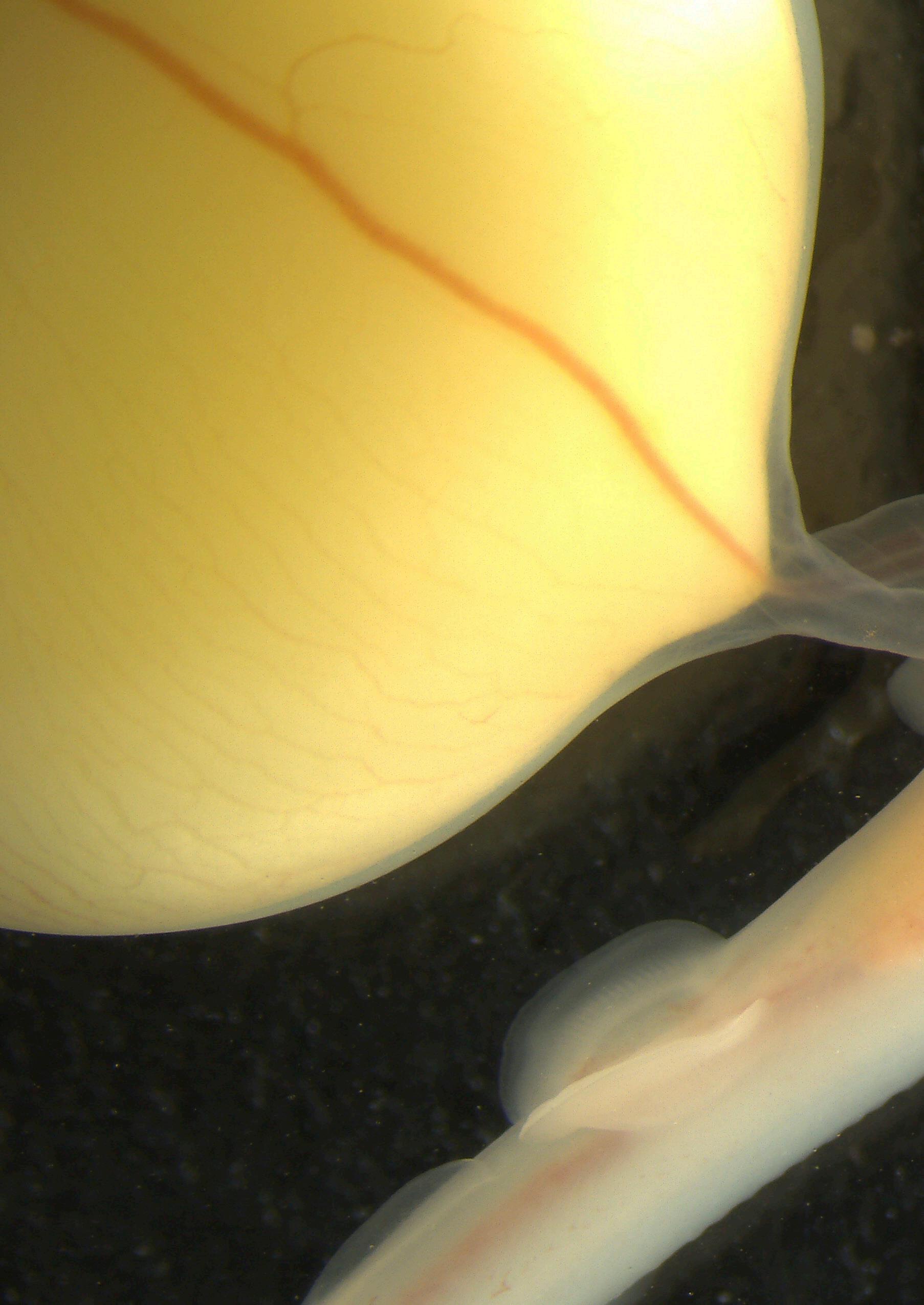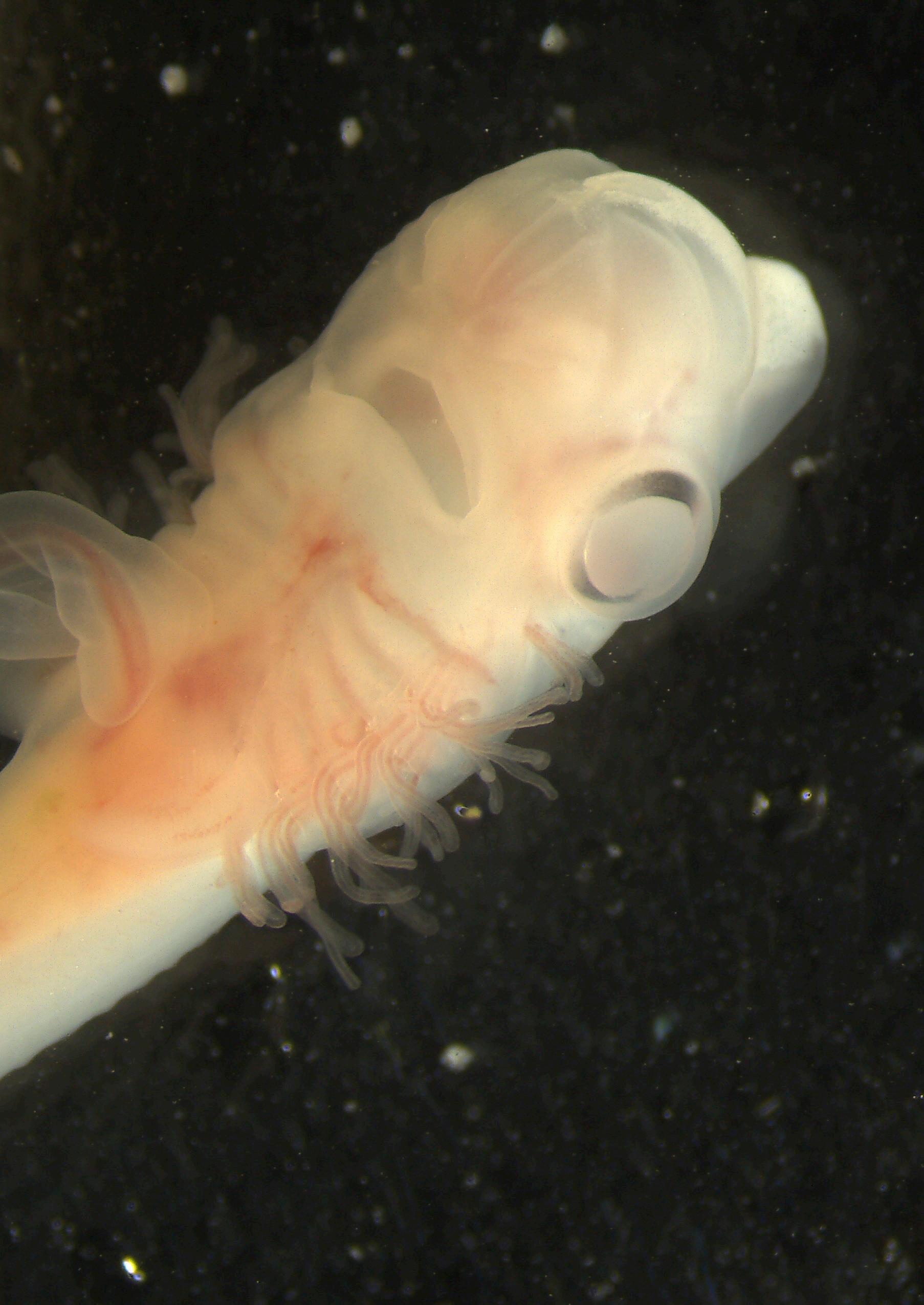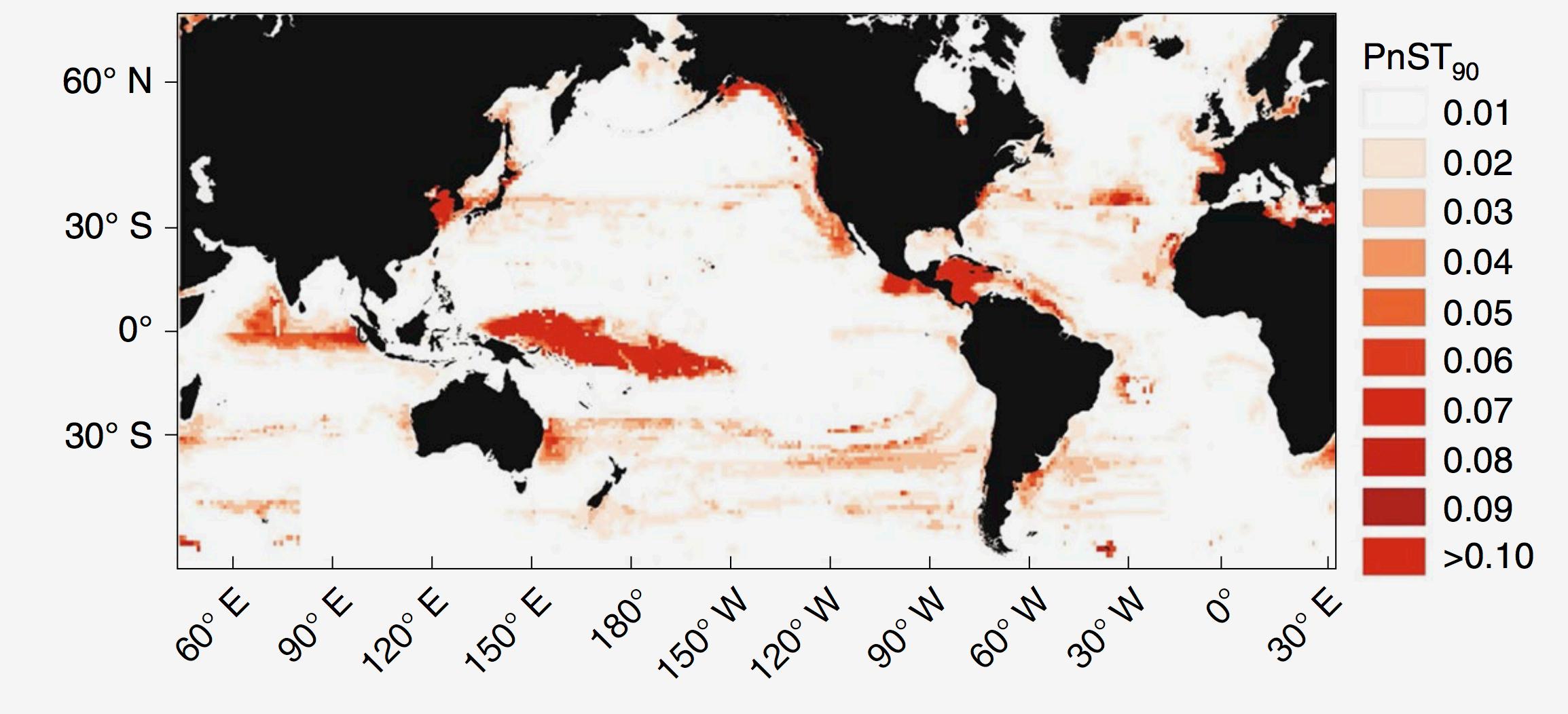
10 minute read
Sharks and Climate Change

Small-spotted Catshark embryo (Scyliorhinus canicula) recovered from discarded females – Madrid 2020.
FEATURE FERNANDO REIS PHOTOGRAPHY PABLO GARCIA
SENTINEL SPECIES
More than a third of the currently known shark and ray species are, according to the IUCN (International Union for Conservation of Nature) Red List, threatened or nearly threatened with extinction. And rising water temperatures could be their worst enemy.
Every year, between 63 and 273 million sharks die in the oceans solely for their fins. The exact numbers remain as estimates, as there is a huge lack of reliable data (www.iucnssg. org/faqs.html). The truth is that by the number of fins commercialised, it is known that the worldwide number of unreported cases of illegal fishing is extremely high. More so, the incidental catches usually known as bycatch, are nowadays very significant in commercial fishing activities worldwide, and illegal fishing is of course undeclared which derives from the international trade in demand for fins and shark meat. There are many pressures that threaten the survival of many of the species of rays and sharks. These factors make ray, skates and shark fishing a totally unsustainable economic activity today.
As apex predators of each ecosystem or trophic network they control, elasmobranchs (1) are considered sentinel species and main regulators of the entire balance of marine biodiversity. Without them the global fish economy and marine life as we know it, would change significantly. Sentinel species can provide us insights about each ecosystem function, identify hidden risks to human health, and predict future change. As sentinels, many shark species offer a unique perspective into ocean processes, given that they can move across ocean basins and amplify trophic information across multiple spatiotemporal scales (Hazen et al, 2019). It is expectable that the use of marine predators as ecosystem sentinels will enable humans a better and faster response and adaptation to each ecosystem variability and change.

Proportion of species beyond their 90% species thermal range –PnST90 (Smale et al, 2019).
WHAT’S HAPPENING NOW?
But, there are also many other indirect threats to the survival of shark and ray species, which are undoubtedly the result of human action and which must be considered: the loss of habitats, the climate change and, in particular, the warming of ocean waters, with the consequent increase in acidification of the waters due to excess carbon dioxide. In reality, the oceans are the main source of thermal inertia in the climate system (Resplandy et al, 2019), vital for life on the planet. And this is so significant that the absorption of heat and carbon dioxide by the oceans represent more than 90% of the excess energy obtained by the Earth.
In fact, water temperature is one of the most important factors of environmental balance that regulates the distribution of different species by each different habitat. When we study sharks, the most important question we should always ask is what is that animal doing there at that moment. It is known that the oceans have warmed up substantially over the past century, with far-reaching implications for all marine ecosystems. No one can forget the repeated phenomena such as “El Niño” responsible for the deaths of so many large areas of coral habitats in the Indian Ocean. Unfortunately, we are aware that anthropogenic climate change (2) has redistributed species and reorganised natural systems, posing a great threat to global biodiversity as we know it. The marine biosphere has become so heated in recent decades that its implications for the integrity of ecosystems pose a real threat to the sustainability of the economy of goods and services they provide to different populations around the world.
A group of Australian scientists led by Dan Smale from the Marine Biological Association of the Unite Kingdom, compared the areas where heat waves have increased the most in places that harbour a lot of biodiversity, looking towards where the species are already near their temperature limit, compared to those where additional stresses occur, such as pollution oroverfishing (Smale et al,2019).This study reveals critical points of environmental damage from the Caribbean Gulf, to the western Pacific, and even to the nor theastern Indian Ocean, just between Maldivian waters and the western coasts of Indonesia (see the map of the proportion of species beyond their 90% species thermal range – PnST90 – Smale et al, 2019).
PUFFADDER SHYSHARKS
Another thing we know is that the skin of sharks is covered with denticles (3) that provide each animal with a layer of resistant and protective dentin, and that saves them a lot of energy when swimming, but they are also very vulnerable to ocean acidification. In South Africa, another team of scientists last year presented conclusions from the negative consequences resulting from the acidification of the waters in the corrosion of these denticles. Dentin corrosion appeared on the skin of a group of three Puffadder Shysharks (Haploblepharus edwardsii) after an experimental exposure of 9 weeks of hypercapnia (4) concluding that its result increase in denticles renewal can potentially compromise hydrodynamics and skin protection. As shark teeth and denticles are structurally and materially identical, the chemical dissolution of teeth can also be expected at a similar rate (Dziergwa et al, 2019). The combination of these multiple effects will most probably cause a negative affect to the survival of many species of top predators, making sharks and rays particularly susceptible to ocean acidification.
POT JACKSON SHARKS
Two years ago, a different group of Australian researchers hatched 24 eggs of the Port Jackson shark (Heterodontus portusjacksoni) Half of these eggs were placed in water that was maintained at current temperature averages, and the rest were placed in slightly heated tanks to simulate projected temperature changes towards the end of the century. Five of the sharks in the highest temperature tankhad died the firstmonth,and the survivors were placed in a long tank with a Y-shaped partition with food on each end. Sharks incubated at high temperature showed a stronger absolute laterality and leaned significantly to the right in relation to sharks reared at the current temperature (Catarina Vila Pouca et al, 2019). This lateralisation is the tendency of one or the other half of the brain to automatically control certain behaviours. It is one of the fundamental patterns of the organisation of the brain not only of animals, but also of humans. It is believed that sharks born in warmer waters may be forced to develop faster, which would lead to smaller brains than those that develop under current conditions. With less mental energy, sharks tend to follow certain “autopilot” behaviours, such as always turn right.
SMALL-SPOTTED CATSHARKS AND BLACKMOUTH CATSHARKS
On another side of the planet, in Spain, since March of this year, the Oc eanogràfic Foundation and the scientific Lamna Association started working together on the Valencian coast, to present the results obtained in a project to recover Small-spotted Catshark eggs (Scyliorhinus canicula) from the discarded fishing females. The research work conducted by the Professor Pablo Garcia with the high school students allowed them to see how temperatures affected the speed of the embryos development.
They had two aquariums, one with the sea temperature and the other with the sea temperature in a supposed climate change scenario. In addition, they had females obtained from fishing discards, provided by a local fisherman.From each female theyhatched two eggs, one for each aquarium, and observed how long development took in each scenario. In addition, they also controlled the survival rate. In the end they concluded that growth at higher temperatures was faster in warmer water, but mortality was much higher during growth. Cold-water animals grew slower, but mortality was much lower. They blamed it on increased bacterial growth in the hotter water and yolk shedding for lack of consistency.
Similar results, were obtained with the deep-sea species Blackmouth Catshark (Galeus melastomus) developed at a higher temperature than normal. At 14ºC the eggs develop with a survival of more than 80%. But, just by raising them to 16ºC, survival dropped to 60%. With this, the research students and professors have been able to confirm that with warmer water, the shark eggs develop faster, but they also have a higher risk of mortality and therefore there is less reproduction.
THE CONFIRMATION
As we have been able to confirm, more and more scientists are investigating how climate change is affecting biodiversity and assessing the vulnerability of species under these global warming phenomena. It is also known that sharks and rays that can live in fresh water in estuaries and reefs are known today to be the most vulnerable to climate change. Increasing water temperatures and excessive concentrations of carbon dioxide in the oceans are affecting the development of the sharks’ brains This not only represents a serious threat to marine ecosystems, but also to the animals that inhabit them, including its main predators without which we cannot survive.
Sometimes it seems, we can only have hope for the generations to come. For example when we see public statements by teenagers like Greta Thunberg, in this case those published in Rolling Stone magazine last April, “It seems like the people in power have given up. They say fighting climate change is too hard, it’s too much of a challenge.” (Stephen Rodrick, 2020) But, as Greta said in Davos, Switzerland, in the 2020 World Economic Forum, this is a matter of life and death for the future of our species, we cannot give up. “If we are to be in-line with the carbon-dioxide budget, we need to focus on doing things now instead of making commitments like 10, or 20, 30 years from now.”

Small-spotted Catshark egg (Scyliorhinus canicula) recovered from discarded females – Madrid 2020.
FOR THIS NOT TO HAPPEN AGAIN
The oceans are really what gives us this urgent alarm of how fast the Earth is warming up. Unfortunately, today the link between the unbridled consumption of many species of wildlife, climate change, the destruction of natural systems worldwide and the appearance of COVID-19 are also undeniable. The truth is that everything that our generations have produced, the good and the bad, have transformed current living conditions and especially those that will come. And many of these transformations are already irreversible.
Today, more than ever, we must reflect on the consequences of our actions. It is time to change our ways in nature. We must be aware that we are part of it, and not against it. After dealing with the current coronavirus crisis, each of us will have to take time to change attitudes, and to undertake new protection and recovery measures for large areas of land and ocean. This is, if we want to work together so that pandemics like COVID-19 do not happen again. And consequently that we can make room for the environmental reconstruction of the planet, and that we can prevent key species such as sharks and rays from extinction.
(1) Elasmobranchs –Cartilage skeleton animal subclass consisting of rays and sharks.
(2) Anthropogenic –Resulting from the impact of human activity.
(3) Denticles –Small, tooth-like scales that cover the skin of rays and sharks.
(4) Hypercapnia –condition of abnormally elevated bicarbonate.
ACKNOWLEDGEMENTS: Jaime Penadés Suay and Pablo García –Spanish researchers from the Lamna Association of the Valencian coast and the IES Gonzalo Chacón de Arroyomolinos in Madrid, respectively.
REFERENCES: CatarinaVila Pouca, Connor Gervais, Joshua Reed y Culum Brown, 2018 –Incubation under Climate Warming Affects Behavioural Lateralisation in Port Jackson Sharks –Symmetry 2018,10,184 - Symmetry MDPI, Basel Switzerland.
Hazen, E.L.; Abrahms, B.; Brodie, S.; Carroll, G.; Jacox, M.G.; Savoca, M.S.; Scales, K.L.; Sydeman, W.J.; Bograd, S.J., 2019 –Marine top predators as climate and ecosystem sentinels –Frontiers in Ecology and the Environment, Wiley Periodicals Inc. –Ecological Society of America, doi:10.1002/ fee.2125.
Jacqueline Dziergwa, Sarika Singh, Christopher R. Bridges, Sven E. Kerwath, Joachim Enax y Lutz Auerswald, 2019 –Acid-base adjustments and first evidence of denticle corrosion caused by ocean acidification conditions in a demersal shark species –Scientific Reports, nature research, (2019) 9:18688.
Resplandy, L.; Keeling, R.F.; Eddebbar,Y.; Brooks, M.; Wang, R.; Bopp, L.; Long, M.C.; Dunne, J.P.; Koeve, W.; y Oschlies, A., 2019 –Quantification of ocean heat uptake from changes in atmospheric O2 and CO2 composition –Scientific Reports, nature research, (2019) 9:20244.
Smale, D.A.;Wernberg,T.; Oliver, E. C. J.;Thomsen, M.; Harvey, B. P.; Straub, S. C.; Burrows, M. T.; Alexander, L. V.; Benthuysen, J. A.; Donat, M. G.; Feng, M.; Hobday, A. J.; Holbrook, N. J.; PerkinsKirkpatrick, S. E.; Scannell, H. A.; Gupta, A. Sen.; Payne, B. L.; Moore, P. J., 2018 –Marine heatwaves threaten global biodiversity and the provision of ecosystem services –Nature Climate Change | Vol 9 | April 2019 –pp.306-312.
Stephen Rodrick, March 26, 2020 –How one Swedish teenager armed with a homemade sign ignited a crusade and became the leader of a movement –Rolling Stone,April 2020 Issue 1338. (www.rollingstone.com/politics/politics-features/ greta-thunberg-climate-crisis-cover-965949/)
FOR MORE INFO: EMAIL: info@sharksinstitute.org WEBSITE: www.sharksinstitute.org










